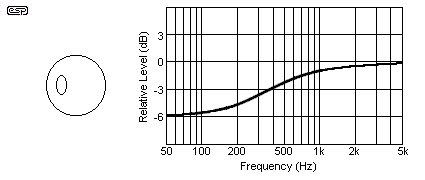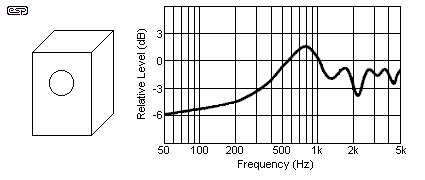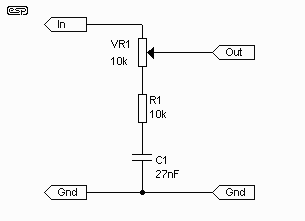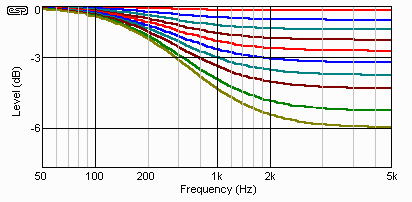
 |
The Audio Pages |
| Elliott Sound Products | Baffle Step Compensation |
Copyright ![]() 2001
- Rod Elliott (ESP)
2001
- Rod Elliott (ESP)
Page Updated 08 Dec 2001
Introduction Baffle Step Response Baffle Step Equalisation Variable Equaliser References
The so called "baffle step" is an increase in output from a loudspeaker as the size of the baffle becomes significant in terms of the wavelength of sound for a range of frequencies. At low frequencies, where the baffle (the panel the loudspeaker is mounted on) is small compared to the wavelength, the speaker is assumed to be operating with a spherical radiation pattern. While this may be the case should the speaker be situated up a tree in the middle of a field, it hardly qualifies as true when the same loudspeaker is installed in your listening room. There may of course be something about you that I don't know (for example that your speakers really are up in trees), but for the majority this will not be the case.
As frequency increases, the size of the baffle becomes significant, and the spherical radiation pattern no longer applies. This is also partly to do with the loudspeaker drivers themselves - as frequency increases, typical cone drivers become more and more directional anyway - this occurs as the dimensions of the cone become significant with respect to wavelength.
It has been shown by Olson et. al. that the optimum enclosure for a loudspeaker driver is a sphere - that is to say that there is no "baffle" as such, but that the driver is installed in a spherical enclosure. While this is all very well in theory, spheres are hard to build, and even harder to include in a typical lounge room unobtrusively.

Figure 1 - Response Behaviour
- 300 mm Sphere (After Olson)
The increase in output can be seen as the dimensions of the sphere approach the wavelength of the reproduced frequency. Once the wavelength is smaller than the diameter of the sphere, the response flattens out again, having risen by 6dB from the low frequency level. The radiating efficiency of the driver starts to increase earlier than one might imagine - there is a 1dB increase in SPL at the frequency where the baffle is about 0.2 of a wavelength, and the baffle step effect has no influence when the baffle width is greater than 3 wavelengths. At this point, the driver is effectively radiating into a hemisphere.
The absolute worst enclosure is a circular tube (cylinder), with the driver mounted in the exact centre of an end-cap. The response ripples caused by this are extreme, but with most systems this is not an issue, since this would be a very unusual shape for an enclosure. The response in a cylinder shows fluctuations in level that are quite unacceptable, and it is not a shape I would recommend to anyone. A cube is little better, and again the effect is made very much worse if the driver is mounted in the centre. Bacause these shapes are (or should be) avoided altogether, I have not included any response graphs.

Figure 2 - Response Behaviour
- 300mm Wide Rectangular Box (After Olson)
The overall behaviour is greatly improved with any mounting method if you ensure that the centre of the driver is a different distance from each edge of the box. These distances should be "non-harmonic", which is to say that they should be different, but in such a way that no one distance is an even multiple of any other.
When the distances from the driver centre to three sides are equal, the response will be much like that shown in Figure 2. This is better than a cube or cylinder, but much greater improvements can be made, just by changing the position of the driver. In addition, rounded edges will cause less refraction than square or raised edges, further improving the overall response, and particularly at the higher frequencies.
The baffle step is easily compensated for where the speakers are mounted in trees or are in other (more sensible) outdoor environments, but becomes much more difficult as a normal listening room is introduced. Adjacent walls, cabinets and other furnishings will all have an effect, and the outcome is unpredictable at best.
It has been determined that the baffle step may only be a couple of decibels in some circumstances, and sometimes less. In a normal room, it is unlikely that the step will be greater than 3dB, unless the speakers are a considerable distance from the walls.
To this end, I have determined a simple passive network that allows you to adjust the level with a pot, until the response is optimum. The frequency is fixed, and is easily determined based on the width of the baffle. The equaliser circuit should be placed between the preamp and power amp - it is not suitable for use in the speaker lines. Although circuits exist for use in the speaker lines, I would not recommend them in any situation, since power losses are very high, and they cannot be adjusted easily to suit your listening environment.
Based on an excellent formula developed by John Murphy (True Audio), we can calculate the frequency easily for the box ...
f3 = 115 / WB
(where WB is the baffle width in meters)
f3 = 380 / WBNeedless to say, I will use metres, and as shown in the graphs above, will use a baffle 300 mm wide. The frequency is therefore ...
(where WB is the baffle width in feet)
f3 = 115 / 0.3 = 383 Hz
A circuit is needed that will provide a typical 3dB decrease in level at the calculated frequency, and the (very simple) schematic is shown in Figure 3.
The value of C1 is determined by the following (1/2 of the pot value is added to the resistor value, since both are in series, and a typical situation will have a pot setting of around halfway - there will always be some error, but it will normally be quite small in practice) ...
C1 = 1 / 2 *Since the formula will regularly give values that are not obtainable, we may use the closest available value with little error. Certainly the error will be very much smaller than that created by the room acoustics and other influences. The sample circuit is shown in Figure 3, and as shown is valid for a box with a 300mm wide baffle. The only change that you will need is to the value of C1 according to the above formula.* (R1 + (VR1 / 2)) * f
C1 = 1 / 2 ** 15k * 383 = 27nF
(NOTE - Formula amended 08 Dec 2001, after a reader pointed out that the resistor and pot are in series, and therefore both affect the response.)

Figure 3 - The Baffle
Step Correction Circuit
It is essential that the compensation circuit be driven from a low impedance source, and the load impedance should be reasonably high. There will be little error with loading above 20k, but basically the higher the impedance, the better. Opamp buffers at the input and output may be used if you cannot ensure that the source impedance is 100 ohms or less, and that the load impedance of the following stage is greater than 20k. My recommendation would be to use a buffer stage at the output with an input impedance of about 100k.

Figure 4 - Typical Frequency
Response at 10% Increments
As shown in Figure 4, the pot may be moved from a flat response right through to full 6dB compensation. The graph shows 10% increments of the pot. When the pot wiper is at the top of its travel (based on the schematic), the circuit is inactive, and maximum compensation occurs at at the opposite end of the pot's travel. Nearly all normal listening room environments will use a setting somewhere in between.
| Copyright
Notice. This article, including but not limited to all text and diagrams,
is the intellectual property of Rod Elliott, and is Copyright |